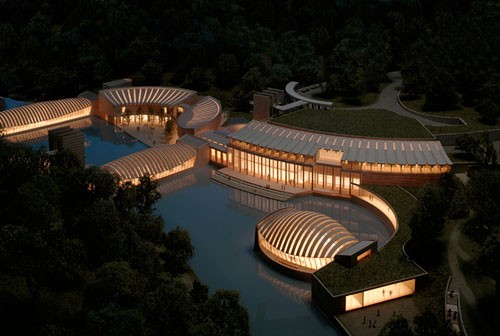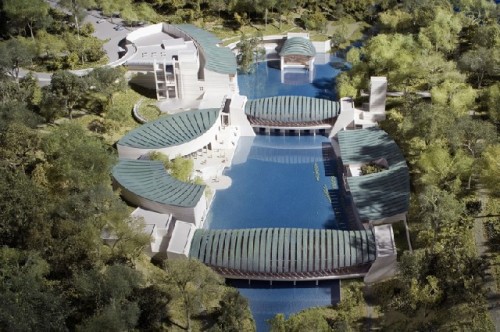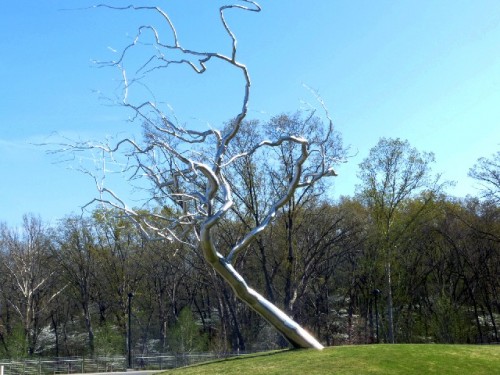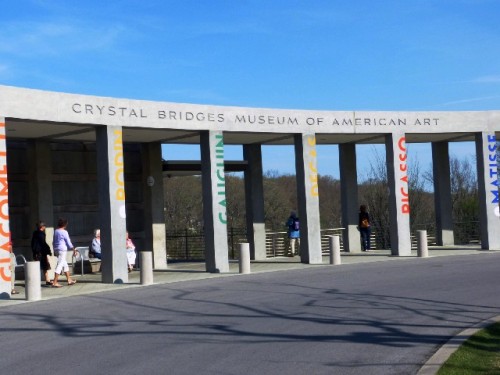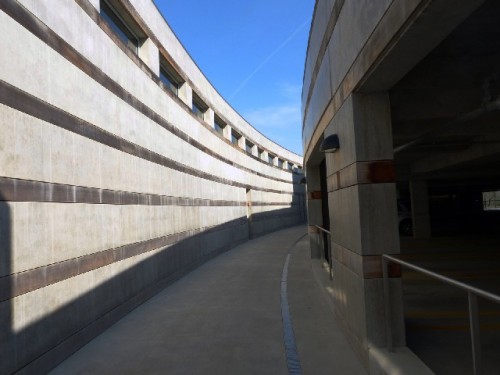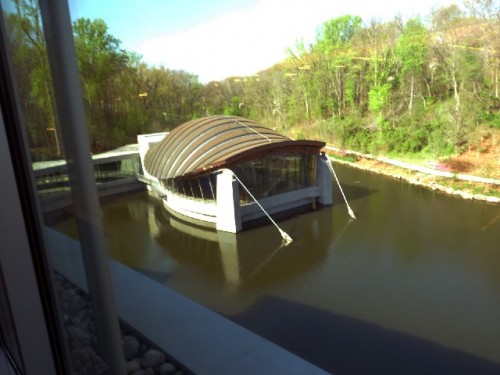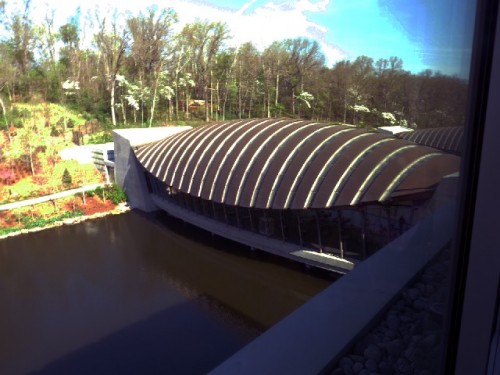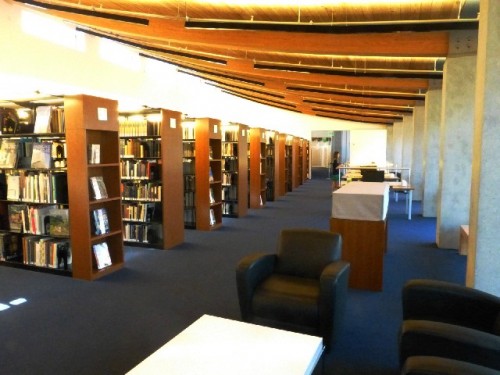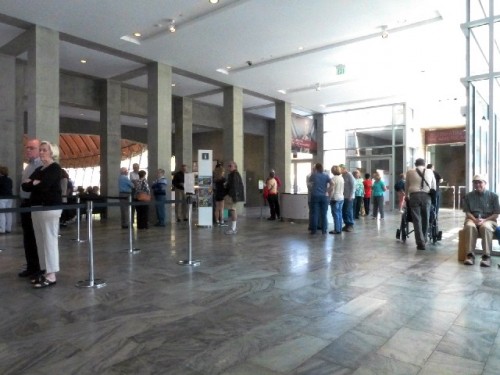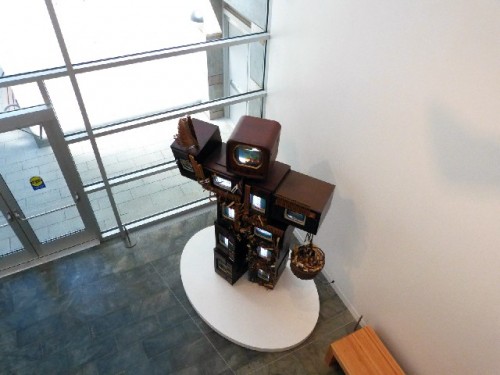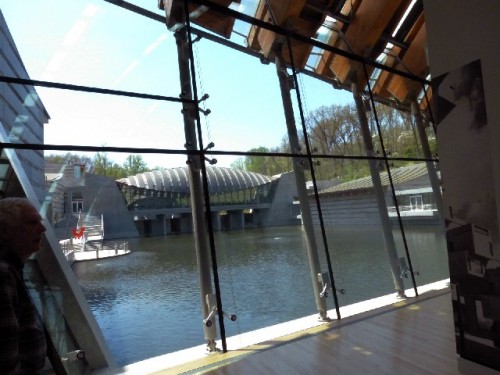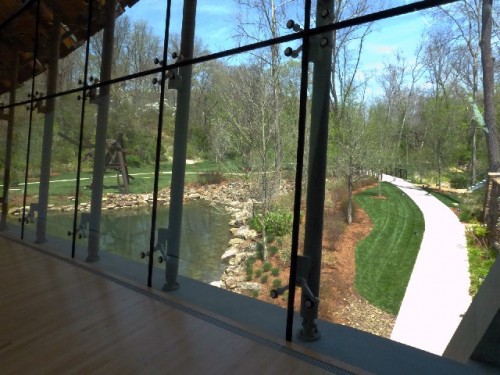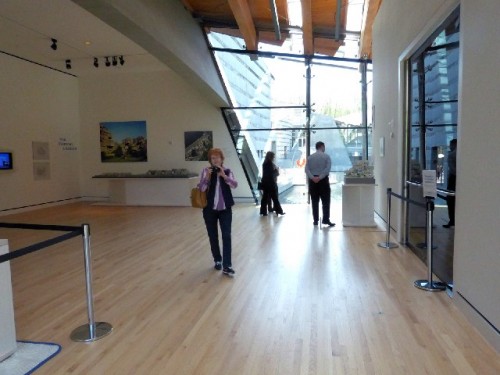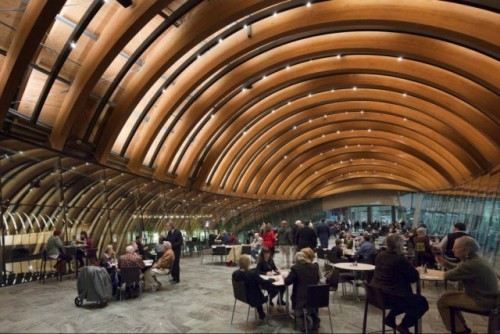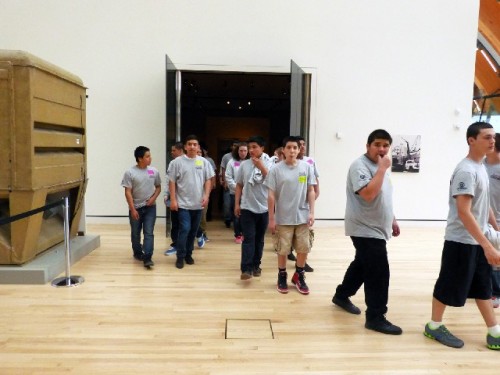Alice Walton’s Crystal Bridges
Bringing Iconic American Art to Arkansas
By: Charles Giuliano - Jun 11, 2014
Since opening on 11/11/11 Crystal Bridges Museum of American Art in Bentonville, Arkansas headquarters of the Walmart corporation, qualifies for the short list of finest museums devoted to collecting and displaying the full spectrum of American art from Colonial times through the present.
The museum provoked controversy when founder and Walmart heir, Alice Walton, one the world’s wealthiest individuals made controversial acquisitions of iconic works long associated with other institutions.
New Yorkers cried foul when Asher B. Durand’s “Kindred Spirits” and several other works were deaccessioned by the New York Public Library. An attempt to purchase a Thomas Eakins masterpiece “The Dr. Gross Clinic” aroused patrons to keep the painting in Philadelphia. Some $68 million was raised to meet the asking price of the city’s Thomas Jefferson Medical College. While that painting remained in Philadelphia another portrait by Eakins from the college was acquired by Crystal Bridges.
Works of this quality are becoming available because of the financial and administrative stress of many museums and educational institutions. Increasingly works of art are being viewed as liquid assets to reduce deficits or fund expansion and other projects.
There has been a melt down at the National Academy of Design.
As M. H. Miller reported in The Gallerist on events the week of June 9, 2014 “The National Academy Museum and School has let go several members of its staff, including both its registrars, the marketing director, the building manager and senior curator Bruce Weber. Dr. Marshall Price, the museum’s contemporary curator, left on his own volition in March to become a curator at the Nasher Museum of Art at Duke University.
”According to sources with knowledge of the situation, the National Academy’s director, Carmine Branagan, told the museum’s board that the reason the employees were let go was financial, but the real reason stems from disagreements within the institution over its future direction—namely, the promotion of Maurizio Pellegrin, a member of the school’s faculty, to the powerful position of creative director of both the National Academy School and its museum, which are located in a townhouse on Museum Mile.
”Mr. Pellegrin is an artist by trade, and has not previously held a curatorial role in a museum. Mr. Pellegrin’s friend, Filippo Fossati, the former co-owner of New York’s Esso Gallery and a part-time secondary market dealer, was also hired as a curatorial adviser, though his museum experience is limited.”
Responding to these developments Dr. Patricia Hills a Boston University Professor sent an e mail to colleagues “I want to remind everyone that about ten or fifteen years ago the NAD sold their Woodville ‘War News from Mexico’ to Richard Manoogian. A dealer said it was a hush-hush deal and none of the dealers had a chance to bid on it. The work hung at the National Gallery, but was sold to Alice Walton. So it is at Crystal Bridges I presume.”
The renowned painting by Richard Caton Woodville was indeed among the masterpieces we encountered during a recent visit to the museum.
Arguably few of the 500,000 annual visitors to the museum are aware of the controversial provenance of many of the works on view with their encyclopedic range from the Colonial era to contemporary American art.
With a confluence of major works of art and superb architecture in dialogue with nature Crystal Bridges provides a richly satisfying experience for its visitors. It is among the most inviting and beautiful small museums in America.
The museum with its series of pontoon like sections is nestled in a ravine straddling a pool enlarged from a flowing Ozark stream. The museum is one of the finest designs by Moshe Safdie who was born in Israel in 1938.
What follows is a dialogue with a spokesperson for the museum.
Diane Carol Crystal Bridges sits on 120 acres which were gifted to us by the Walton Family Foundation. It is land that’s adjacent to downtown Bentonville which is just a short walk from here but it had never been developed. It’s typical of the Ozarks landscape where it’s hilly and wooded with ravines and streams.
When the architect Moshe Safdie saw the site his first thought was to integrate the museum in one of the ravines. It would best to integrate art and nature. It’s a world class art collection on 120 acres of land.
It is a surprise to people driving along the main street thinking that they would see a big building. Instead Safdie created a journey. When you pull in from the street you can’t see the museum. You park, come to the museum, and then it’s terraced down. You approach from the parking lot then come down by elevator to the lobby. From there it reveals itself. You see through all the windows.
This is our museum restaurant which is actually a bridge structure. The water flows beneath it. The pond that you see is filled by Crystal Spring. It goes underground and then bubbles up in certain spots. It is a constantly renewing spring.
Charles Giuliano Is it potable?
DC We haven’t tested the water for that. It connects with several city streams. The bridges of Crystal Bridges comes from these bridge structures. The bridges are constructed so that water is incorporated throughout. There is the gallery bridge as well. Crystal Spring is a smallish stream that originates right by the bridge. These ponds were excavated from the nearest spring to begin with. They are filled through the source. They flow under both buildings and then goes on to a more narrow Ozark spring. It’s not any contained water it’s a natural ecosystem. There’s everything that one finds in native streams from crawfish, turtles, beavers, herons, egrets, and all kinds of natural life. Everything we do is with sustainability in mind not to negatively impact the quality of the water because it is an ecosystem.
CG You recently acquired a Frank Lloyd Wright building.
DC We have. It’s the Bachman Wilson house from New Jersey.
CG Is it a Usonian House?
DC It is.
CG So it must be quite compact say about 900 square feet.
DC No it’s closer to 2,000 square feet. It was built in 1954 with much of the furniture built in.
(The Bachman Wilson house was designed by Frank Lloyd Wright in 1954 for Abraham Wilson and his first wife, Gloria Bachman. Ms. Bachman's brother, Marvin, had studied with Wright at Taliesin West.
The front façade of concrete blocks has an almost fortress-like appearance to ensure privacy from the street. The house is built with Way-Lite concrete blocks and Philippine mahogany trim. It has a second story, rare in a Usonian house, with cantilevered balconies. The living room has a built-in banquette facing a wooded scene through a wall of 10 foot high glass panes, symbolizing a transcendental pew set before the altar of nature.
The public space is a dramatic focal point, with walls of glass and an open floor plan. Cut-out wooden panels of abstracted forms over 24 clerestory windows provide an unobtrusive yet restrained decorative touch to this lavish space.
In 1988, Sharon and Lawrence Tarantino acquired the neglected Bachman Wilson House. Tarantino Architects has since restored the home and rebuilt the kitchen according to Wright's original drawings. Sharon and Lawrence Tarantino have received several awards for their restoration including the Wright Spirit Award.
The house is located along the Millstone River in Millstone Borough. It exemplifies Wright's "Usonian" philosophy and employs his early green building principles, including minimizing the size of the house and ancillary spaces, pioneering passive solar and radiant heat design, employing natural daylight and recycling construction waste.
Its location is prone to flooding. On January 15, 2014 the Crystal Bridges Museum of American Art announced that it was acquiring the Bachman-Wilson house.)
The house had been impacted by hurricanes and rising water. It’s being rescued. The owners were a husband and wife architectural team. They updated it twelve times. It’s been flooded and nearly destroyed multiple times. So the Tarantinos started looking for a new owner. They were looking for a museum setting to preserve the house.
It was dismantled before spring weather was at its peak with possibly more damage. It was shipped in containers and arrived here last week. (April, 2014) It’s in storage and we’re beginning site prep.
We are standing in our gathering place which we call our Great Hall. If you go out our South Lobby and up the stairs you’ll see where the house will be sited. You can actually see some construction underway. It will be up that hillside and overlook Crystal Spring. It’s a similar to New Jersey where it overlooked the Millstone River.
CG Are there other Wright houses in Arkansas?
DC No. There’s one in Oklahoma which is about two hours from here. It’s the Price Tower which had residential and office tower space.
CG As I understand it then the collection policy of the museum includes all of American art from Colonial times to the present as well as architecture.
DC That’s accurate although I would not say that we have an active policy for architectural acquisition. It was an opportunity which presented itself. We had the right site and availability of land to make that happen. Basically it was a house in need.
CG When the museum opened the collection comprised 440 works of art. What is it today?
DC That’s about right. Now (two and a half years later) it’s about 2,400. Some of that can happen in big chunks. In 2012 we acquired a print collection. It had been in a private European collection for decades. It had never been publicly exhibited. We purchased that…
CG What’s the time frame of the collection?
DC It’s early 1900s. It’s about 500 pieces.
CG American?
DC Yes, all American.
CG You collect only American but you are showing European art as well.
DC We have a temporary exhibition of European modernism. (The William S. Paley Collection: A Taste for Modernism, March 14 to July 7)
CG Is there a heart and soul of the collection? I’m thinking of “Kindred Spirits” by Asher B. Durand. Has the collection been built around that as a focal point?
DC That’s probably a better question for some of our curatorial team. (Hesitates) I tend to hear a variety of people form their own assessment about that. It is a strength of the collection but it is obviously such a new and young collection and it is based on what becomes available in certain moments of time.
(“In May 2005 the New York Public Library allowed its star painting, Durand’s 1849 “Kindred Spirits,” to be spirited away for about $35 million by the Walmart heiress Alice L. Walton, who is building the Crystal Bridges Museum of American Art in Bentonville, Ark.
“The sizable painting depicts two friends and well-known New York cultural figures, the landscapist Thomas Cole, who had recently died, and the poet-journalist William Cullen Bryant, communing on a rocky ledge in a scenic gorge. It’s a moving if slightly schmaltzy tribute to the richness of the city’s cultural patrimony. Donated to the library in 1904 by Bryant’s daughter, the painting had been there for more than 100 years, and is arguably Durand’s best-known and most striking work, evoking the majesty of nature while emphasizing its harmony with the human spirit. The painting’s removal from its native habitat is a real loss…” Grace Gleuck, The New York Times, March 30, 2007 The museum also acquired from the NPL “Mrs. Theodore Atkinson, Jr.” (1765) a Colonial era portrait by the Boston artist John Singleton Copley.)
CG Who is making acquisition decisions for the museum at this time? The director was shifted to the board and the initial curator was not retained. So who is now in charge?
DC Our museum president is Don Bacigalupi.
(“…who has overseen the Toledo museum in Ohio for the last six years and before that served as the director of the San Diego Museum of Art, said he had not sought the job but became enthusiastic about it after meeting with Ms. Walton in the spring…
“Mr. Bacigalupi (pronounced BAH-chee-ga-loop-ee) said his decision to leave an established museum for a new and untested one was motivated partly by the seriousness of Ms. Walton’s intentions. ‘She is one of these enlightened patrons,’ he said. ‘She’s an heiress who could obviously do anything she wanted with her resources.
“ ‘This is a not a vanity project,’ he added, ‘and it’s not just a personal collection that’s going to be opened to the public.’ “ Randy Kennedy, The New York Times, August 17, 2009)
Don is an art historian (specialty post 1945 American art) and has been with the museum since 2010 I believe.
(Prior to the appointment of Bacigalupi the primary advisor of Ms Walton was John Wilmerding. He brokered several controversial acquisitions like “Kindred Spirits” including a failed attempt to pry loose the Thomas Eakins masterpiece “The Dr. Gross Clinic” from Thomas Jefferson Medical College in Philadelphia which commissioned the iconic portrait which is considered to be the artist’s masterpiece. The sum of $68 million was offered by Walton in a potential partnership with the National Gallery where Wilmerding has a long association. It was matched and the painting remains in Philadelphia.)
CG Is there a chief curator at this time?
DC There is an open search going on.
CG When the initial curator was not retained it was not clear in the media how that would be handled.
DC No, not for the chief curator position. There was a different position when we opened which was more of an administrative curatorial position. You can imagine it was a brand new building with hundreds of works of art in crates. There were decisions of how to place, display and all of those elements. The curatorial team worked in conjunction with the director of exhibitions. They launched the debut of the collection. That was a position which was then rolled into a broader exhibitions position. The chief curator position became an active search as soon as that person moved on.
CG Can you describe the acquisitions committee?
DC It includes our curatorial team, museum president, executive director and deputy director as well as our board of directors.
Astrid Hiemer During the structural development of the museum were there discussions between the architect and curators?
DC Absolutely. It was a multi year process. It took about six years to design and build the museum. Many of the works had been on loan to other institutions before we had exhibition space for them. That was a process of looking at the collection and deciding how best to exhibit it. It was a multi layered process.
AH Were the curators on staff during those six years?
DC I would have to look back to see when they were hired. I began in 2012 so I can dig deeper and do some research for you. We’re standing in our restaurant which is called Eleven. It was opened on 11/11/11.
CG Discuss education programming.
DC We have a grant from the Walker Family Foundation. They have funded the school field trip program. We are the only fine arts museum in our region so many of the students had never visited amuseum.
CG Are there other museums in Arkansas?
DC There’s the Arkansas Arts Center in Little Rock.
(It is located on the corner of 9th and Commerce streets in MacArthur Park, Little Rock. The AAC was founded in 1960, but the idea began in 1914, when the Fine Arts Club of Arkansas formed. The group included supporters and volunteers who contributed to the realization of the Museum of Fine Arts in 1937. The center features a permanent collection along with occasional special exhibitions.
It doesn’t have the square footage of our exhibition space.
Within our area you have to drive two hours to Tulsa, Oklahoma, three hours to Kansas City, or three hours to Little Rock for its Fine Arts Museum. That’s from right here. If you were in a rural area the distances would be even greater.
We have an enormous educational impact. The school program was started shortly after we opened. It’s a free program. Schools apply then there’s a lottery to fill the slots. Gas is reimbursed. Substitute teachers are reimbursed. They come for a half day visit including a complimentary lunch. We have about 45,000 school children per year. There has been a significant survey of the impact for kids who would not otherwise have had a museum experience. It was found that it increased their understanding of historic concepts. They had the experience of walking through history in the collection. It increased their understanding of ethnicity such as what it meant to be an African American artist at a certain moment in time. Being a female artist. It increased their critical thinking skills. It increased their interest in being a future arts participant. Not necessarily that they wanted to be artists but that they wanted to have more involvement with art.
CG What is the total annual attendance?
DC It is around a half million visitors. We have been open a little less than three years and we have had 1.3 million visitors. Our entire DMA (Designated Marketing Area) is 450,000. In a region of our size that’s incredible. We have had visitation from all 50 states as well as internationally. It breaks down that 60% of our visitation is within a day’s drive. The next 20% is within a five hour drive and the remaining 20% is beyond that and international.
CG If the museum is collecting aggressively where are you putting it? Particularly given the scale of contemporary art.
DC We have about 50,000 square feet of exhibition space. There’s temporary exhibition space in addition to that. The permanent collection is rotated frequently.
CG How has the museum responded to controversy? There was considerable media coverage, for example, when “Kindred Spirits” (1849 by Asher B. Durand) was acquired after a long presence in the New York Public Library. Or similar responses to the attempt to purchase “The Dr. Gross Clinic” by Eakins from the Jefferson Medical College in Philadelphia. There has been discussion of the museum tipping the market.
DC The best answer to that is the proof of time. People are seeing “Kindred Spirits.” We are a highly accessible museum. The museum is free. You walk through the doors of our galleries and see “Kindred Spirits” and other great artworks and you’re not going to have to pay a fee to do that. We are here. Yes we are in Arkansas. “Kindred Spirits” is here in Arkansas but 1.3 million people have walked past it.
CG The institution has received a lot of negative media and how does the institution respond to that?
DC Give me a for instance.
CG Going after works long associated with other institutions. Having the biggest pile of chips when bidding for available masterpieces which generally raises acquisition costs for other institutions.
DC You could dissect that case by case.
(For example the small, predominantly African American, Fisk University going to court to break the will of Georgia O’Keeffe’s gift of 101 works owned by her late husband Alfred Stieglitz to Fisk University in Nashville. For some $30 million Crystal Bridges is now co-custodian of a collection evaluated at $75 million. The collection is rotated every two years. It was on view during our visit. Fisk was also gifted $1 million to renovate its museum. Part of the $30 million went to settling the university’s legal fees.)
A variety of people are going to form a variety of responses. So it’s impossible to address. We are an American art museum that collects stellar examples of American art as are other institutions and we share them publicly. They are acquired with the ability of the public to view and enjoy.
CG The museum has been founded with resources from the Walton Family Foundation. Is that a positive or negative over time in terms of attracting donations from other private collectors and foundations? Are we to look at this as an Arkansas based museum or a Walton Family museum? There are now a number of major private collections that have matured to looking for museums to acquire and display them. Some but not all collectors, like Alice Walton, opt to form their own museums while others prefer to work with already established and expanding institutions. This is a generational phenomenon that we have seen in the development of great museums. Does the dominant presence of the Walton family dampen the potential interest of other major private collectors?
DC We have found that it has not. If you walk down that hall you can see on the wall the names of some of our other sponsors.
(Willard and Pat Walker, The Tyson Family, J.B. Hunt, Windgate Charitable Foundation, Jack and Melba Shewmaker, and others.)
We are a very public welcoming institution. We are a non profit institution and we want to welcome all to the American spirit. In a setting that combines art and nature. That’s something that resonates with a wide range of people be they individuals or corporations. We are increasing access to the arts in a region that has not had that. The Walker Family Foundation is an example of a completely separate family representing stepping forward and saying we are so glad this is in our region. We see what your doing and can make a difference by getting more school kids to go there. So they created an endowment for the school trips program.
CG Are there other collectors in the region?
DC Not historically. But in Arkansas yes of course.
CG Is this a stimulus to that activity?
DC We believe so. It’s only been open for two and a half years. So it’s hard to track some of those results. During the summer before we opened we offered memberships and we had 3,000 people sign up. Consider that we’re a free museum. Usually one of the perks of membership is free admission. That was 3,000 people within six days saying we’re so glad you’re here and we want to be a part of it. We have levels of membership and programs comparable to other museums.
CG Does John Wilmerding continue to have a role with the museum?
(Wilmerding, born in 1938, is descended from prominent New York families. He received a Harvard A. B. in 1960, masters in 1961, and PhD in 1965. From 1977 to 1983 he served as senior curator at the National Gallery of Art and deputy director from 1983 to 1988. He is Christopher Binyon Sarofim Professor of American Art at Princeton. Wilmerding has announced that his entire collection of art would remain at the National Gallery. It includes works by Martin Johnson Heade, Fitz Henry Lane, John F. Peto, Joseph Decker, Winslow Homer, Thomas Eakins, Frederic Edwin Church, George Caleb Bingham, and John F. Kensett, as well as works by various artists who visited Maine’s Mount Desert Island. He has advised Alice Walton on controversial acquisitions.)
DC John has been on our board of directors and I will have to look at his term and its expiration. He was on our founding board. He had been an advisor to Alice Walton from before the formation of the museum.
CG When did she start collecting?
DC He has been involved for a number of years. We just had an exhibition which has come down of some of her favorite water colors. It’s one of the ways in which she started collecting. She used to paint as a kid when they did family trips. She and her mom would set up by a stream and do water color paintings. It’s always been a passion of her’s. She’s a learner. She’s a very inquisitive person. Something would catch her eye and she would delve more deeply.
(Alice Louise Walton (born October 7, 1949) is an American heiress to the fortune of Walmart Stores. She is the daughter of founder Sam Walton and Helen Walton. In March 2012, her estimated net worth was US $26.3 billion, making her the second-richest American woman (behind her sister-in-law Christy Walton) and the tenth-richest American. As of February 2014, her estimated net worth was US $33.9 billion, making her the 13th richest person in the world.)
CG There have been media comments regarding the early departure of the founding director and curator. That there does not appear to be a clear focus and mission statement.
DC That’s a question for our director.
(Crystal Bridges Museum of American Art Board of Directors and board chair Alice Walton promoted Crystal Bridges Executive Don Bacigalupi who has been shifted from Executive Director to President of Crystal Bridges and a board member. The board has also promoted Crystal Bridges Deputy Director for Operations and Administration Rod Bigelow to executive director. Bacigalupi serves as a member of the board of directors and advances the Museum’s national and global special initiatives and works closely with the board and staff leadership. Bigelow assumed oversight for day-to-day operations of the Museum. Three of the four senior curatorial staffers including, David Houston, former curatorial director, Matt Dawson, former deputy director for art and education, left the museum shortly after it opened. )
Don has been working on a project that opens here in December. It is called State of the Art Discovering American Art Now. Don traveled for the past nine to twelve months. He and another curator working on the exhibition have met with over a thousand artists all across the US in studio visits. It started with a list of some 10,000 artists. They gathered it through peer conversations with other curators, gallery owners, educational centers. It included a broad network of people who know what’s going on in their regions.
CG How many artists will be shown?
DC Approximately a hundred.
CG It will be interesting to see what he comes up with.

